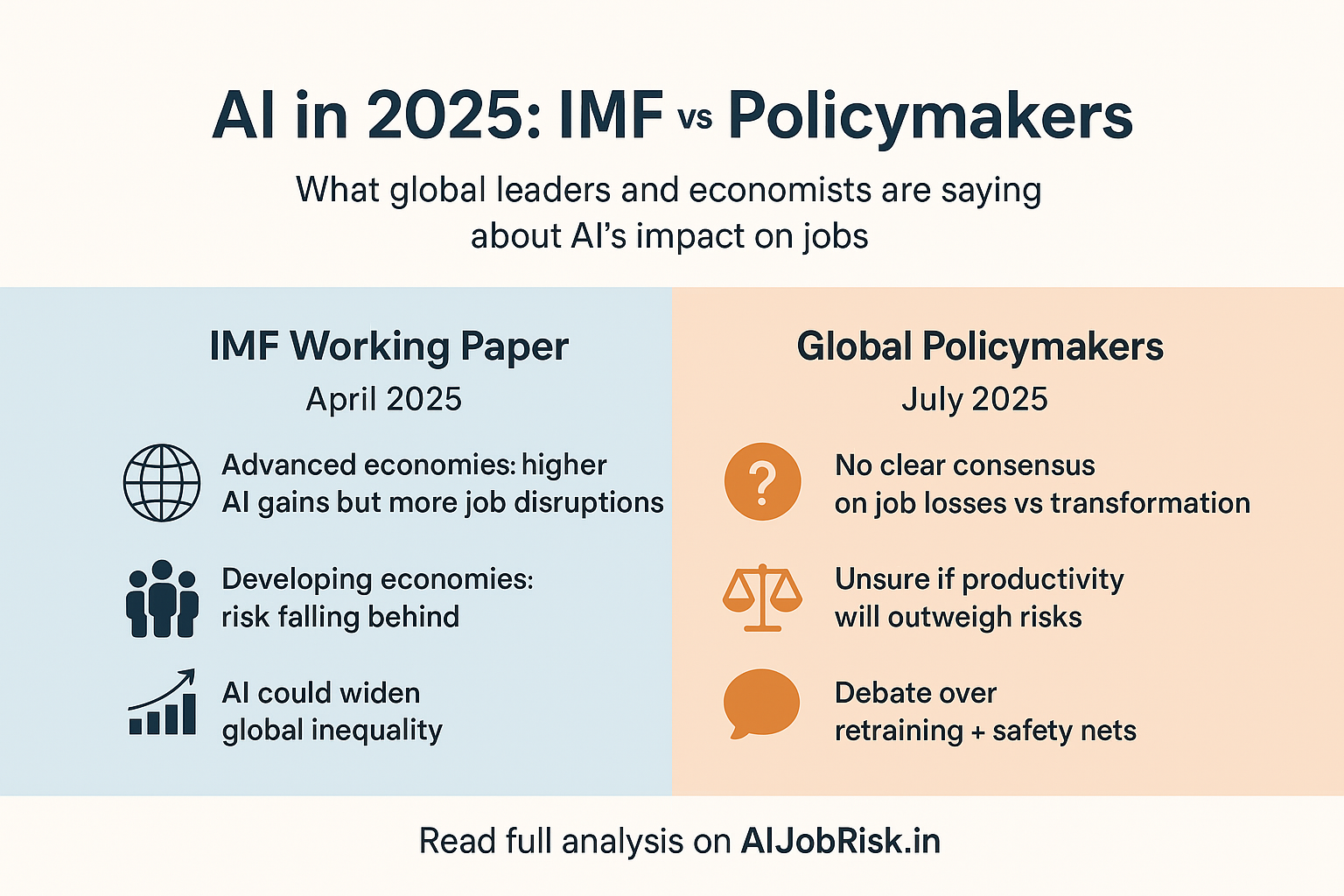Artificial Intelligence (AI) is no longer a distant promise—it’s here, it’s powerful, and it’s reshaping the global economy. In 2025, the debate isn’t about if AI will change work, but how deeply it will disrupt jobs, industries, and inequality worldwide.
In April 2025, the International Monetary Fund (IMF) released a working paper, “The Global Impact of AI: Mind the Gap”, warning that AI could widen the inequality gap between advanced and developing economies. Just months later, in July 2025, the Financial Times reported that policymakers remain divided and uncertain about AI’s true impact on jobs, highlighting how governments are still struggling to respond to this fast-moving transformation.

For India, this debate is more than academic. With a workforce of over 500 million and one of the world’s largest IT and outsourcing industries, the country faces both risks and opportunities as AI adoption accelerates.
Together, these insights reveal a critical truth: AI’s influence on work and economies is unfolding right now and the outcomes are far from certain.
What the IMF Found in 2025
The IMF’s research highlights several important trends:
- Advanced economies are more exposed to AI benefits (like higher productivity) but also to potential job disruptions.
- Developing economies risk falling further behind, as they lack the infrastructure, capital, and digital readiness to adopt AI at the same pace.
- This imbalance could widen the global inequality gap, with wealthier nations reaping AI’s rewards while poorer countries struggle to catch up.
The IMF warns that without proactive policies, AI could reinforce global divides rather than close them.
Why Policymakers Are Still Unsure in 2025
While the IMF paints a clear picture of risks and opportunities, global policymakers remain hesitant.
In July 2025, the Financial Times reported that government officials and central bankers still lack a consensus on:
- How many jobs AI will replace versus transform.
- Whether productivity gains will outweigh job losses.
- What kind of social safety nets and retraining programs are needed.
This uncertainty reflects the complexity of AI’s impact unlike past technological shifts, AI doesn’t just automate manual work but also white-collar tasks like analysis, writing, and customer service.
Jobs Most at Risk from AI
Drawing from both the IMF’s data and ongoing debates:
-
- Advanced economies: Jobs in finance, professional services, clerical roles, and customer support are most at risk.
- Developing economies: Lower exposure due to reliance on manual labor, but risks grow as digital adoption increases.
- Global divide: Skilled, AI-adaptive jobs will thrive; routine, replaceable jobs are in danger.
Curious about your own career?
Try our AI Job Risk Calculator →
See how safe your job is from automation — and discover the skills that can keep you future-proof.
India’s Crossroads: AI Risk or AI Opportunity?
“TCS recently announced 12,000 job cuts linked to AI, while an EY study warns that 38 million Indian jobs could be reshaped by 2030.”
India presents a unique case. The country’s IT and Business Process Outsourcing (BPO) industries employ millions and generate billions in export revenue. These sectors are directly in AI’s path.
-
- At-risk sectors: Customer service, back-office operations, and routine IT support are among the first to face automation through AI chatbots, coding assistants, and process automation.
- Opportunities: India’s digital economy, already strong in fintech, e-commerce, and health tech, could benefit from AI-driven efficiency and innovation.
- Upskilling imperative: With one of the world’s youngest workforces, India has the chance to pivot if it invests heavily in reskilling programs for AI, data analysis, and advanced digital skills.
“AI could become the most disruptive force for inequality in decades.” — IMF, 2025
In short, India could either be one of AI’s biggest success stories or one of its most vulnerable casualties, depending on how policymakers and industries act now.
The Bigger Picture—Opportunity vs. Risk
Both the IMF and policymakers agree on one thing: AI brings opportunity and disruption.
- Opportunities: Productivity gains, new AI-driven industries, efficiency in services.
- Risks: Rising inequality, job losses in vulnerable sectors, uneven benefits across countries.
The uncertainty itself is a trend—governments, businesses, and workers must act now to prepare for multiple scenarios.
Key Takeaways — AI’s Global Impact in 2025
- IMF warns: AI could widen inequality between rich and developing nations.
- Policymakers divided: No consensus on job losses, safety nets, or retraining programs.
- Jobs at risk: Finance, IT/BPO, clerical, and customer service face early disruption.
- India’s crossroads: Outsourcing is vulnerable—reskilling could unlock major opportunity.
Conclusion
As of mid-2025, one fact is clear: AI’s global impact is no longer theoretical, it’s real, disruptive, and uneven.
The IMF warns of rising inequality between advanced and developing nations.
The Financial Times shows policymakers are still divided on job risks, safety nets, and retraining.
By 2030, AI could add $15 trillion to the global economy—but also leave millions of workers behind.
India stands at a turning point—outsourcing jobs face disruption, yet with reskilling and digital investment, the country could become a global AI success story.
👉 For workers, the best move is to reskill, stay adaptable, and follow AI trends closely.
👉 For policymakers, the challenge is to design forward-looking strategies that maximize AI’s benefits while minimizing risks.
👉 For businesses, the responsibility is to adopt AI responsibly, balancing efficiency with inclusivity.
This is the reality of the future of work in 2025: a powerful yet unpredictable AI-driven economy. And the conversation—whether in Washington, Brussels, or New Delhi is only just beginning.
For readers: an AI Job Risk Calculator shows how different careers may be affected by automation.
